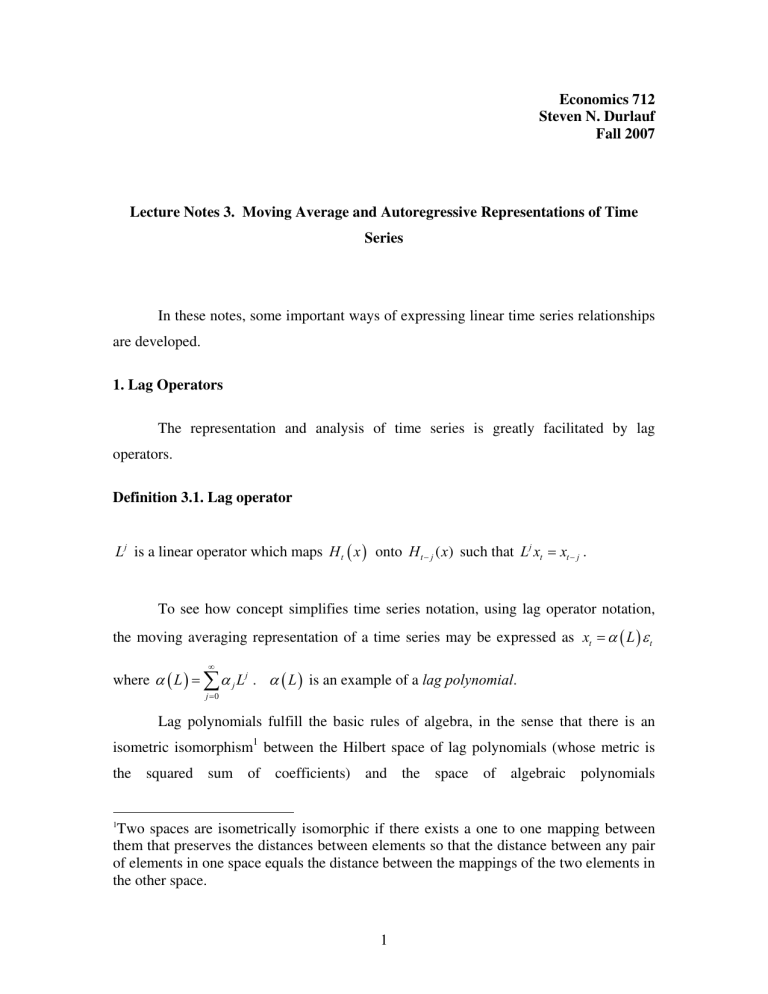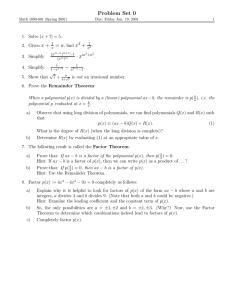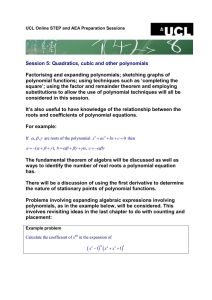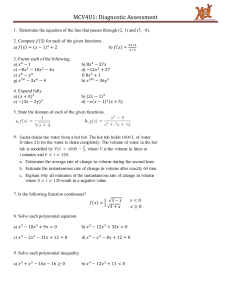Moving Average and Autoregressive Representations of Time Series
advertisement

Economics 712
Steven N. Durlauf
Fall 2007
Lecture Notes 3. Moving Average and Autoregressive Representations of Time
Series
In these notes, some important ways of expressing linear time series relationships
are developed.
1. Lag Operators
The representation and analysis of time series is greatly facilitated by lag
operators.
Definition 3.1. Lag operator
Lj is a linear operator which maps H t ( x ) onto H t − j ( x) such that Lj xt = xt − j .
the moving averaging representation of a time series may be expressed as xt = α ( L ) ε t
To see how concept simplifies time series notation, using lag operator notation,
where α ( L ) = ∑ α j Lj . α ( L ) is an example of a lag polynomial.
∞
j =0
Lag polynomials fulfill the basic rules of algebra, in the sense that there is an
isometric isomorphism1 between the Hilbert space of lag polynomials (whose metric is
the squared sum of coefficients) and the space of algebraic polynomials
1
Two spaces are isometrically isomorphic if there exists a one to one mapping between
them that preserves the distances between elements so that the distance between any pair
of elements in one space equals the distance between the mappings of the two elements in
the other space.
1
c ( z ) = c0 + c1e − iω + c2 e − i 2ω ..., ω ∈ [ −π , π ] . As a result, restrictions on operations with lag
polynomials are straightforward to identify.
This equivalance between the properties of lag operators and complex
polynomials is a consequence of the fact that the Hilbert space l 2 , which is defined as the
Hilbert space generated by all square summable sequences of complex numbers
m = (… mi −1 , mi , mi +1 …) , endowed with the inner product
⟨ m, n⟩ =
∑ mn ,
∞
i =−∞
i i
is
isometrically isomorphic to the Hilbert space of L2 functions, generated by complex
valued functions f (ω ) defined on the interval ω ∈ [ −π , π ] 2 and endowed with the inner
product
⟨ f , g⟩ = ∫
π
−π
f (ω ) g (ω )dω . The key idea is that each element of l 2 maps to an
element of L2 in a way that preserves distances is formalized in the Riesz-Fischer
Theorem. Notice that I state the theorem in terms of an orthonormal basis of L2 , the
normalized complex exponentials. This orthonormal basis is the foundation of the theory
of Fourier analysis, which I will not develop further here.
Theorem 3.1. Riesz-Fischer Theorem
Define the sequence of orthogonal polynomials (relative to the L2 norm)
φ j (ω ) =
e − ijω
2π
(3.1)
and denote c as any square summable sequence {… , c−1 , c0 , c1 ,…} . Then there exists a
function f (ω ) ∈ L2 such that
i.
2
c j = ⟨φ j (ω ) , f (ω )⟩ ,
ω is sometimes known as a frequency.
2
the infinite sum fˆc (ω ) = ∑ c jφ j (ω ) arbitrarily well approximates f (ω ) in the
∞
ii.
sense that f − fˆc = 0 .
iii.
j =0
Any two series, c and d, are distinct if and only if the infinite sums fˆc and fˆd are
also distinct, i.e. fˆc − fˆd = 0 .
iv.
f
2
=
∑c
∞
j =−∞
2
j
.
As a result, restrictions on operations with lag polynomials are straightforward to
identify. For example, the product of α ( L) and β ( L) corresponds to the product of
α (e− iω ) and β (e− iω ) . Of particular importance, one can take the inverse of α ( L) if and
only if α (e −iω ) is invertible. When will this polynomial have an inverse? To answer this
question, recall that by the fundamental theorem of algebra, α (e − iω ) can always be
α (e− iω ) = ∏ (1 −λk e− iω ) . A simple polynomial1 − λ e −iω has an inverse if λ < 1 . Hence
factored as the product of simple polynomials, i.e. there exists a representation such that
k
α (e− iω ) possesses an inverse if λk < 1 ∀k . I will return to the question of when lag
polynomials may be inverted.
2. z-transforms
Working with infinite sequences is cumbersome, so it is valuable to be able work
with functions that correspond to them. For a given sequence, one such function is its ztransform. The z-transform of any sequence π j is defined as
π (z)
∑π
∞
j =0
3
j
zj
(3.2)
where z = e − iω . The z -transform is simply another way of describing elements of L2 but
is particularly easy to work with. Notice that the z’s are orthogonal but not orthonormal.
In order to recover the original sequence of coefficients from the z-transform, one can
employ the formula
πj =
1
2π
∫
z =1
π ( z )z j dz =
1
2π
ω
ω
∫ π π ( e )e dω
π
−i
−
ij
(3.3)
The z-transform of the autocovariances,
σ x ( z) =
∑ σ ( j )z
∞
j =−∞
j
x
(3.4)
may not exist for all ω ∈ [ −π , π ] , i.e. the function may be unbounded for some
summarizes all second moment information in the time series. Notice that this transform
frequencies.
The z-transform α ( z ) similarly fully characterizes the Wold moving
The relationship between σ x ( z ) and α ( z ) is important from the perspective of
average representation.
inference as it is only the autocovariances which are observable from the data. Time
series data are simply realizations of a stochastic process. One can compute sample
autocovariances which, under mild regularity conditions, will represent consistent
estimates of the population autocovariances. Our question is how to use these estimates
to identify the moving average parameters of the process.
As a preliminary to establishing this relationship, the following theorem
establishes a relationship between any set of MA coefficients3 and the associated
autocovariances of a time series.
3
This means that the theorem does not assume that the moving average representation is
the fundamental one.
4
Theorem 3.2.
Relationship between autocovariances and moving average
coefficients.
If xt =
∑γ η
∞
j =−∞
j t− j
, then σ x ( z ) = σ η2γ ( z ) γ ( z −1 ) .
pf. Clearly
E ( γ ( L )ηt , γ ( L ) ηt − k ) = σ η2
∑γ γ
∞
j =−∞
j
j −k
(3.5)
Therefore the z-transform of the autocovariance function is
∑ σ η2 ∑ γ jγ j −k z k = σ η2 ∑
∞
∞
k =−∞
j =−∞
= ση
2
∑γ
∞
k =−∞
∞
j −k
z
k− j
∑γ
k =−∞ j =−∞
∞
j =−∞
∑γ
∞
z jγ j − k z k − j
z =σ η γ ( z ) γ ( z
j
j
j
2
−1
).
(3.6)
This factorization, as noted before, did not require that the ηt ’s were fundamental
for the xt process. In general, the autocovariance function of a stochastic process is
consistent with an infinity of MA representations. Intuitively, this is obvious, since there
is no unique orthogonal basis for H t ( x) . For a specific example, suppose that the
autocovariance function of xt equals 4 z −1 + 17 + 4 z . It is straightforward to verify that
this autocovariance function could have been generated by a moving average
representation of x described by
1
xt = ε t + ε t −1
4
with σ η2 = 16 , or by a moving average representation
5
(3.7)
xt = ηt + 4ηt −1
where σ η2 = 1 .
(3.8)
Both are consistent with the autocovariances embedded in the z-
transform. How can we tell whether either one is the fundamental representation?
3. Fundamental moving average and autoregressive representations
The relationship between the z-transform of the autocovariances and the
fundamental MA coefficients, can be best understood by considering the relationship
between the moving average and autoregressive (AR) representation of xt defined as
β ( L ) xt = ε t
where β 0 = 1 . If α ( L )
−1
(3.9)
is well defined, then the AR polynomial is immediately
generated by the inversion of the MA polynomial, whose existence and uniqueness is
ensured by the second Wold theorem. Consequently, if we can identify the fundamental
MA polynomial and it is invertible, we can identify the AR polynomial. This makes
intuitive sense, since if an AR representation exists, this will define the projection xt|t −1
polynomial c ( z ) may be factored such that
Repeating an earlier argument, the Fundamental Theorem of Algebra, any MA
c ( z ) = Π (1 − λk z )
k
(3.10)
which in turn means that the autocovariance generating function can always be written as
σ ( z ) = σ η2 Π (1 − λk z ) Π (1 − λk z −1 )
k
k
6
(3.11)
We assume that λk ≠ 1 ∀k . Now suppose that λk < 1 ∀k . This means that the
polynomial Π (1 − λk z ) is invertible.
k
Hence this must be the fundamental MA
representation, as it is the MA representation associated with the unique AR
representation. Conversely, suppose that some of the roots are greater than one in
magnitude. Without loss of generality, suppose that only λ1 is greater then one. Rewrite
the σ x ( z ) as
σ x ( z ) = σ η2 (1 − λ1 z ) (1 − λ1 z −1 ) Π (1 − λk z ) Π (1 − λk z −1 )
k ≠1
k ≠1
(3.12)
Now consider the following trick. Since
(1 − λ1 z ) (1 − λ1 z −1 ) = λ12 (1 − λ1−1 z )(1 − λ1−1 z −1 )
(3.13)
σ x ( z ) may be rewritten as
σ x ( z ) = σ η2 λ12 (1 − λ1−1 z )(1 − λ1−1 z −1 ) Π (1 − λk z ) Π (1 − λk z −1 )
k ≠1
k ≠1
(3.14)
The polynomial (1 − λ1−1 z ) Π (1 − λk z ) now possesses all roots inside the unit circle and
k ≠1
therefore is invertible. Hence this is the fundamental MA representation. Notice that the
nonfundamental innovation variance is σ η2 whereas the fundamental innovation variance
is σ η2 λ12 . Therefore, by flipping the roots of any MA representation inside the unit circle,
one can generate the fundamental polynomial structure.
Another way to interpret the transformation of the nonfundamental MA
polynomial is that it is multiplied by terms of the form
λk (1 − λk −1 z )
(1 − λk z )
7
(3.15)
whenever λk > 1 .
What happens when λk = 1 ? This occurs, for example, when
xt = ε t − ε t −1.
(3.16)
In this case, the representation is fundamental, yet there does not exist an autoregressive
representation with square summable coefficients.
Intuitively, the projection of xt
onto H t −1 ( x ) lies in the closure of the linear combinations lagged x’s used to generate the
Hilbert space. Therefore, if the fundamental MA representation of a process is such that
(for at one) λk = 1 , then an autoregressive representation does not exist.
Taking these arguments together, one can conclude that a given MA
representation is fundamental if λk ≤ 1 ∀k .
8






